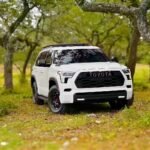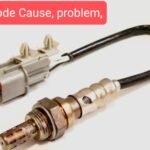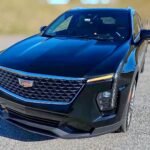A starter motor (starter) is crucial to starting an engine. This equipment is also one of the most common failures in cars. Also called a starter motor, it is a consumable item. If it breaks, the engine will not start, so it is a troublesome part. This article summarizes the role, mechanism, causes, failure symptoms, replacement methods and costs, and replacement companies (maintenance companies) of starter motors.
Table of Contents
Two names: starter and starter motor
The manufacturer’s repair manual describes it as a “starter motor,” so it can be said to be the official name. On the other hand, in the field of maintenance and repair, it is often called a “cell motor.”
starter motor and engine starter

When the general public hears the word “starter,” many think it refers to an “engine starter,” an aftermarket accessory that allows you to start the engine remotely. That starter and the starter (starter motor) described in this article are completely different products.
The starter explained in this article refers to the part installed from the beginning as an essential part of starting the car’s engine.
“Cell” on a bike
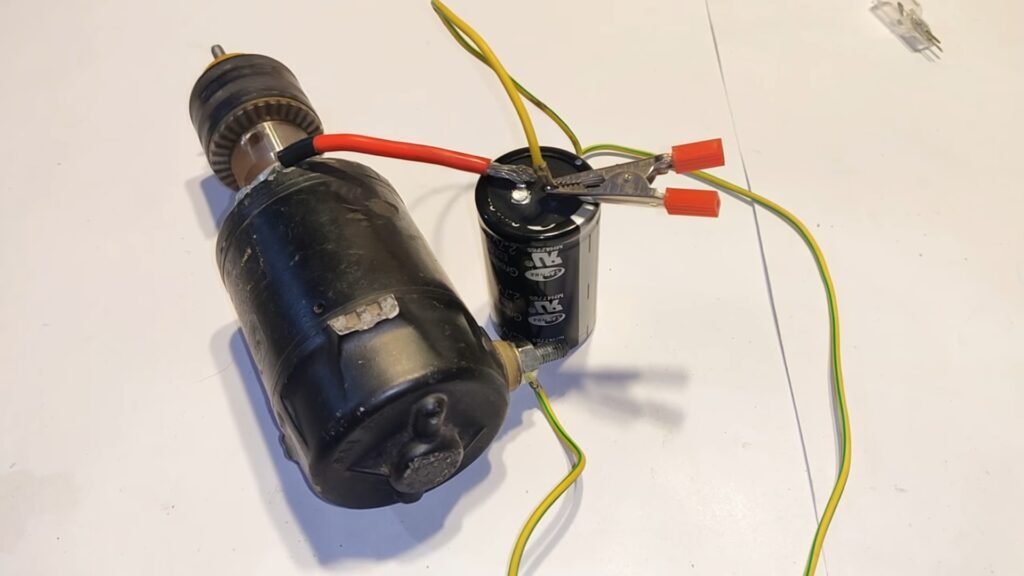
It is commonly called a “cell” on motorcycles and is rarely named a “starter.” The engine squeals when I try to start it. This noise is called “the turning of the cells.”
Origin of cell motor
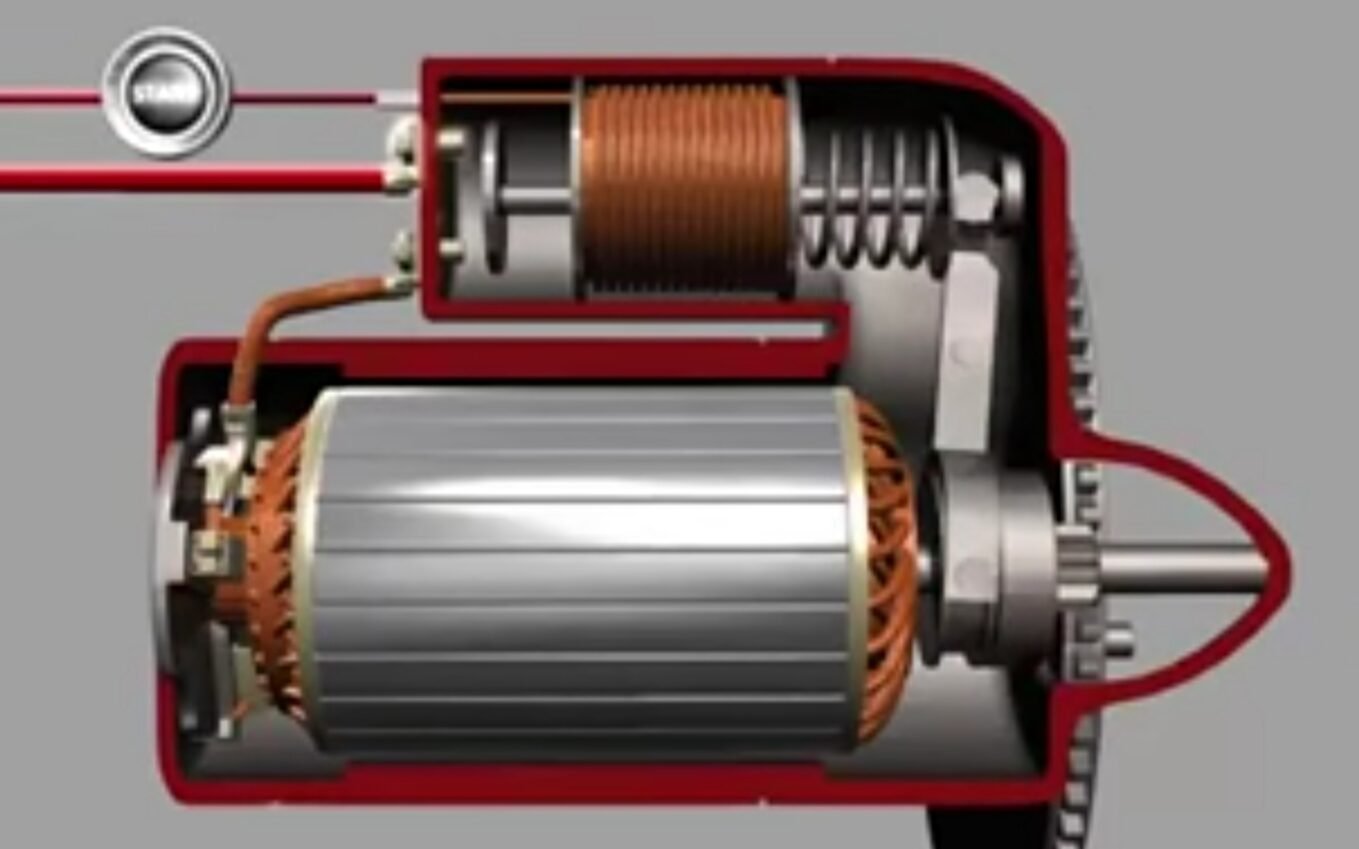
Both cell and motor are English, but the name cell motor is Japanese and only used in Japan. Overseas, it is commonly called a starter motor.
CELL means a cell or private room. The inside of a battery is divided into several compartments, so the term cell is also used.
However, why it is called a cell motor is still being determined.
In this article, we will refer to them as starter motors.
A starter motor that starts the engine: its role and mechanism

It is the starter motor that starts the engine.
A starter motor is a part attached to the engine.
The role of the starter motor is to start the engine but to be more precise; its primary role is to rotate the engine.
Also, the exact installation location is between the engine and transmission.
When the engine starts, it makes a “squeak” sound, but this is the sound of the starter motor turning the engine.
The engine can only be started once the starter rotates the engine.
Starter motor operation

As the name suggests, a starter motor is a “motor.” When electricity is applied, the motor begins to rotate but does not continue to turn forever because its role ends once the engine starts.
Therefore, the gears only pop out and turn when the engine is started.
Starter motor that won’t turn without electricity
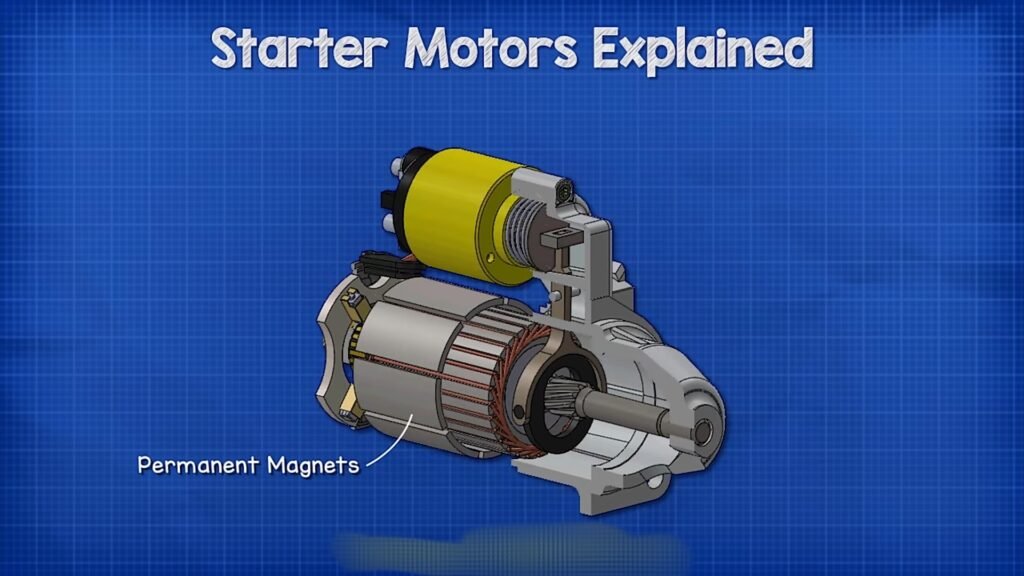
Conversely, if there is no electricity, the starter motor will not run. This is the reason why the engine will not start if the battery is drained = there is no electricity.
What is engine starting?
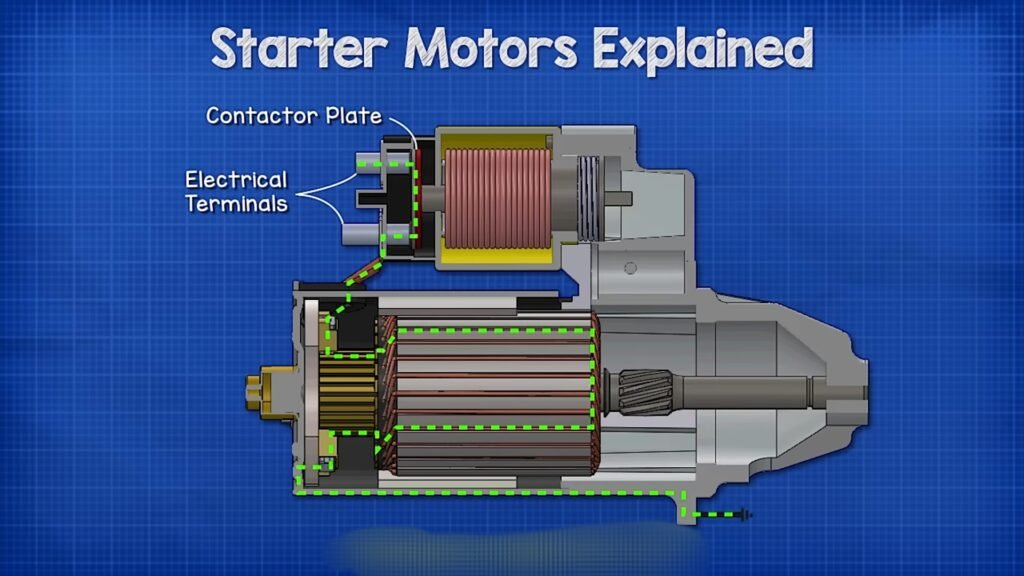
By the way, “starting the engine” refers to the engine starting to rotate on its own.
The video below is a video of the inside of the engine.
Once an engine starts rotating, it can turn until it runs out of fuel. This means that the engine rotates on its own.
However, the engine can only run if it is first rotated by some means.
Therefore, the starter motor is used to rotate and start the engine.
Starter motor life (duration and mileage)

This starter motor is one of a car’s most easily broken parts. They are consumable items and have a limited lifespan. Generally speaking, if either of the following occurs first, it is a sign that it is time to replace the starter motor.
- Period: 10 years
- Mileage: 100,000 km (200,000 km for the latest model car)
Lifespan changes depending on how you drive your car
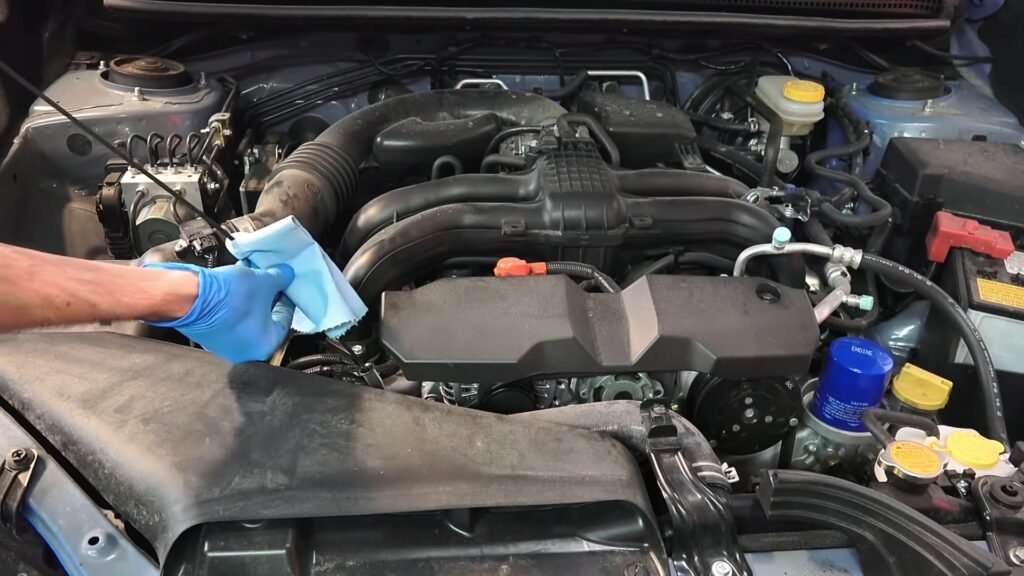
Of course, the lifespan will vary depending on how you ride. Its role is to rotate the motor and start the engine, so the more times the motor is turned, the more likely it will wear out. For example, if you drive short distances frequently, you will start the engine many times, making the starter motor more likely to break.
5 symptoms and 2 causes of failure
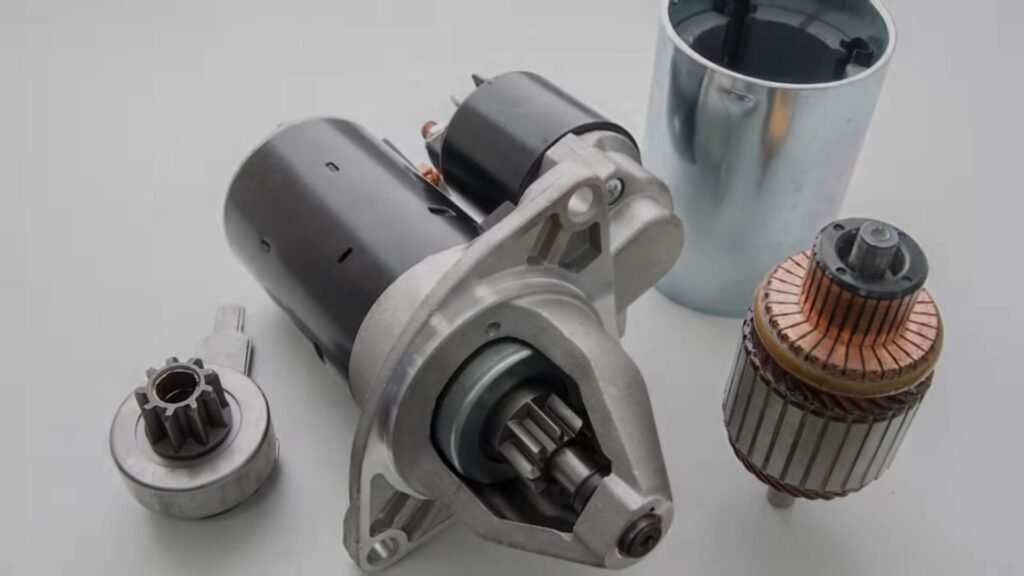
When a starter motor breaks down, the general public can see two or three symptoms from a mechanic’s perspective. So, there are 5 symptoms in total.
Two symptoms – a general perspective
Even the average person can recognize two starter/motor failure/failure symptoms.
- Engine won’t start
- There’s a strange noise
Three Symptoms – Mechanic’s Perspective
When nationally qualified mechanics diagnose starter motor failure, they judge based on three symptoms.
- There is no reaction even when I turn the key (even when I press the engine start switch)
- I only hear a click when I turn the key (when I press the engine start switch).
- The engine starts, but the starter keeps turning (overrun)
It’s okay because regular drivers don’t need to know these things!
Two causes of starter motor failure
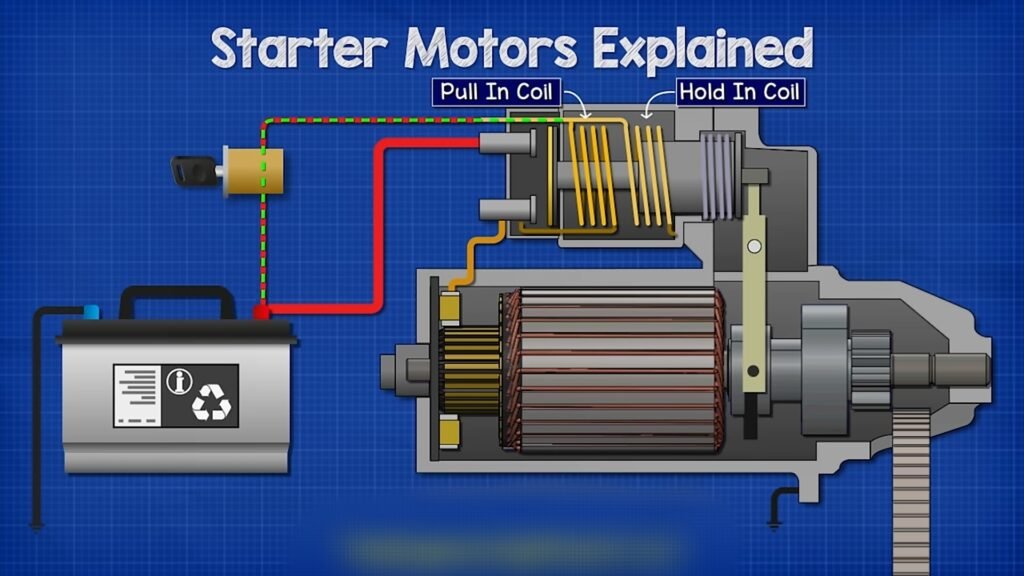
There are two reasons why starter motors break down.
- internal failure
- life
Although the starter has no complicated circuit, it will break due to its large load.
Also, the starter motor is a consumable part. As you continue to use your car, the internal parts will wear out and reach the end of their lifespan.
Cause of failure: 1) Internal failure
Inside the starter motor is a circuit to turn the engine and a circuit to move the gear. This circuit contains coils, switches, etc., and if the coil breaks or the switch makes poor contact, the circuit will be damaged.
Cause of failure 2) Lifespan
The starter motor replacement standard is “10 years” or “100,000 km.”
This life span is caused by the wear of the brushes inside the starter motor.
Brushes are the parts that conduct electricity to the motor, but since electricity flows through the rotating motor, the brushes, which are the contact parts, gradually wear out. The brush is purposely made of soft material. Otherwise, the motor will grind and wear out.
When this brush wears out to the point where it can no longer contact the motor, the starter motor’s life has ended.
However, this brush can be replaced, so if you replace the brush, the starter will start working again.
Is it true that “it moves when you hit it”?
When the starter motor is broken, tapping it may get it working again. This is because the brush did not make good contact with the motor, but when you hit it, it moves and contacts the motor, causing electricity to flow.
However, as this is only temporary, we recommend repairing/replacing the starter motor.
The starter motor does not turn… “Pushing” is impossible in case of failure.
What should I do if the starter motor breaks down and the engine stops running? “Pushing” is necessary if the starter motor stops rotating and the engine does not start in a manual car.
Pushing is a countermeasure that uses human power to make the car and force the engine to start. However, “pushing” is only possible in manual cars, and in automatic cars, if the starter motor breaks down, the engine cannot be started by “pushing.”
In a manual car, the power from the engine is transmitted to the tires through the transmission (gear) and clutch, but in a “push,” the rotation of the tires is sent to the engine, which moves the transmission and clutch to drive the engine. Therefore, starting the engine by pushing in automatic cars is physically impossible where the transmission and engine are not linked.
If you feel that the battery is getting weak or the starter motor is not rotating correctly, have it inspected and repaired immediately? Also, in the unlikely event that the starter motor stops rotating while driving an automatic car, immediately seek assistance from roadside assistance.
What to check if the engine won’t start

If the starter motor does not function properly, the engine will not start. However, not all reasons the engine won’t begin are due to the starter motor.
If the engine doesn’t start won’t, check the following three things to determine the cause.
Are you running out of gas, or is the battery dead?
When you step on the brake and press the start button, there may be no response, indicating that not only is the starter motor malfunctioning, but the fuel is low, or the battery is dead as well. It takes a lot of electricity to run the starter motor, and if you run out of gas or the battery doesn’t have enough power to run the starter motor, the engine won’t start.
If you run out of gas or your battery is dead, you can start the engine by receiving temporary power or fuel from another vehicle.
Is the engine running?
What is often overlooked when the engine does not start is whether the conditions for starting the engine are met. For example, in an automatic car, whether the shift lever is in the “P” position and you are stepping on the brake and pressing the start button, or in a manual car, whether you are stepping on the clutch.
There are many cases where the engine will not start due to a bare operational error. Therefore, if the engine does not start, reconfirm that the environment is suitable for the engine to start before suspecting a problem with the starter motor or battery.
Is the cell motor functioning correctly?
If there are no problems after checking the explained items, suspect the starting motor is malfunctioning. The starter motor rotates at high speed when the engine is started. However, if the starter motor rotates slowly, the engine may not start.
When you press the start button and the starter motor doesn’t work, or when you run out of gas, or the battery dies, contact roadside assistance or your insurance company.
Abnormal noises or weak starter motor sounds are signs of malfunction.
I’m sure many people are wondering how to tell if a starter motor is malfunctioning. Signs of starter motor failure include abnormal noises and a weakening of the starter motor’s sound.
For example, when you start the engine, it stops rotating with a clicking sound, and when you start the engine again, it starts making a strange clicking noise, so be careful. This phenomenon occurs when the switch inside the starter motor is worn out, making it difficult for the engine to start.
Other signs of failure may include the engine running longer than before, irregular starting noises such as “squeaky squealing,” and weak starter motor noise.
If you hit it, it may temporarily improve, and the engine will start, but it does not mean the problem has been fixed. Therefore, if you feel that something is wrong with the starter motor, please have the cause determined by your dealer or maintenance shop.
Repair/replacement methods and costs
As mentioned above, the starter motor is a consumable item, so it is one of the most frequently replaced automotive parts.
Estimated repair/replacement costs
The estimated cost is 200.08$ to 1,000.42$. The difference in price is because the type and performance of the starter motor changes depending on the size of the engine.
repair options
If your starter motor breaks, there are three ways to repair it.
- replace with a new one
- Replace with rebuilt product
- Repair and overhaul broken starter motors
Recommended replacement with rebuilt parts
Replacing it with a new one is the most expensive. Manufacturer’s genuine products have a lot of profit listed on them, so they are inevitably costly. The third option is to repair/overhaul the starter motor. However, the cost varies depending on the parts to be repaired and the details of the overhaul, and the disadvantage is that it takes time to repair parts without replacing them.
The second recommended option is “Replacement with rebuilt parts.” Rebuilt products are the same quality as new ones and have a product warranty (2 years, 40,000 km, etc.), so you can rest assured. However, the cost is about half that of a new one, so it’s easy on your wallet and a highly recommended repair.
Starter motor repair/replacement companies: 4 options
When replacing or repairing a starter motor, there are four main options.
- dealer
- maintenance shop in town
- Autobacs and other car supplies stores
- Mrcarinfo for on-site maintenance and repair
expensive dealer
Dealers are expensive. It varies depending on the car model, but it is the most costly option. We use genuine new products from the manufacturer, and even if you can rebuild products, the labor costs will be high.
maintenance shop in town
Replacing starter motors is a specialty of repair shops. However, the quality of work and prices vary widely, so you must inquire and confirm individually.
Autobacs
At retail/mass retailers like Autobacs, it would be challenging to replace or repair full-fledged parts like starter motors. This is because the type of starter motor installed differs depending on the car model, and it is difficult for retail stores to keep all part numbers in stock.
MRCARINFO for on-site maintenance and repair
At MRCARINFO, we replace starter motors (starter motors) using rebuilt products with a product warranty (2 years/40,000km) on-site. We are a convenient company with low prices and mechanics who can come to you on-site.
- Domestic light vehicle: 293.46$ (including parts cost, business trip fee, and labor fee)
- Domestic regular car: 398.84$ (including parts cost, business trip fee, and labor fee)
- Imported car: 398.84$ (including business trip and labor costs) – Parts costs vary widely depending on the car model, so they are separate
Difference from dead battery
We explained that the symptom of starter motor failure is “the engine won’t start,” but the most common cause of this symptom is “a dead battery.”
When the engine does not start, there are differences between a dead battery and a starter failure.
If the battery is dead
- Electrical components such as navigation and meters do not work
- Battery dead: Engine starts when jumping
In case of starter motor failure
- The engine may or may not start
- There is a strange noise when turning the key
(More details) Two types of starter motors
We will explain starter motors to experts and those who want to know more. The starter motor comes in two types.
- pinion sliding type
- Rev reduction type
Type 1. Pinion sliding type
A pinion sliding starter motor is a type that directly transmits the rotation of the motor to the engine.
Mainly used for small cars and motorcycles.
Type 2. Rev reduction type starter motor
A rev-reduction starter motor has a mechanism that reduces the engine’s rotation.
For example, if the same motor is used, and the pinion sliding type rotates 100 times, the reduction type only rotates 20 times.
This is because a gear is added to the back of the motor to reduce the rotation speed. It is similar to the first gear on a bicycle, and lowering the rotation speed generates a sizeable rotational force with a small amount of force.
The drive gear rotates the motor. The part labeled pinion is the gear that turns the engine. The gear between these two reduces the rotation speed.
Advantages of rev reduction type
The advantage of a rev-reduction starter motor is that it is small and powerful. If the motor is the same as the pinion sliding type, it will be about 3 to 6 times more powerful. On the other hand, if it produces the same output as the pinion sliding type, the motor can be made smaller.
(Trivia) How to start the engine without using a starter motor
A starter motor plays a role when starting an engine. The engine can be created without a starter motor.
The principle is the same: kick and push.
Have you ever seen people “push a car” and start the engine in movies, on TV, or on the roads overseas?
“Kicking the bike” and “pushing the engine” are similar to the principle of a starter motor. Instead of relying on the power of a motor, the engine is rotated using human power or the rotation of the tires. This was the norm when cars were first introduced.
By the way, some lawnmowers and generators start the engine by pulling a string. The principle is the same. The motor rotates by pulling a string wrapped around the engine like a spinning top.
glove box
In the era before starter motors were invented, cars were started by hand. Start the engine by turning the shaft connected to the engine by hand. At this time, I made a box in the passenger seat to store my gloves on my hands. This is the “glove box”. Nowadays, many people put their vehicle inspection certificates on their vehicles, but in the past, they used gloves on their luggage.
You can also use it as a generator.
A motor rotates when electricity flows through it, but conversely, when a motor rotates, electricity is generated. Light uses the rotation of the tires on a bicycle, which uses the rotation of the tires to generate electricity and turn on the light.
Some systems take advantage of this characteristic and use it as both a generator and a starter motor attached to a car.
Nissan’s Eco Motor and Suzuki’s ISG function as a car’s generator (alternator) and starter motor.
Toyota’s hybrid vehicles also have an engine starter built into the hybrid system. Although they do not take the form of the starter motors listed above, they all have the exact role of starting the engine.
FAQ’s
How do starter motors and starters differ?
There is no difference at all! Both starter motor and starter initially come from the word “starter after motor,” and both are abbreviations. Depending on the manufacturer, some call it a “starter motor,” and some call it a “starter.”
How does a starter motor work?
Role and basic structure of starter motor: The idle and clutch gear contact the pinion gear at the motor’s tip to reduce the rotation speed. The pinion gear, which is on the same axis as the clutch gear and rotates at the same speed, turns the engine’s ring gear. This is the mechanism that starts the engine.
What is a car starter motor?
When the starting motor (starter motor) stops turning or makes abnormal noises, what should you do? Starters are electric motors that start engines. In English, it is called “starter motor,” a Japanese-English word.
What is the lifespan of a starter motor?
An average starter motor lasts 10 to 15 years and travels 100,000 to 150,000 kilometers. However, the lifespan will vary depending on how you use it and how often you turn off the engine. If you frequently drive short distances for deliveries, etc., it is a good idea to aim for 100,000km.
What happens if the cell motor breaks?
There is no operating sound, and the engine does not start. If the starter motor is completely broken, you will hear a “click, click” sound like a switch is being turned on even if you turn the key (even if you press the button), but there will be no operating sound. It will look like this. If this happens, the engine will naturally not start, so the only option is to request JAF or roadside assistance and take the car to a repair shop using a tow truck.



